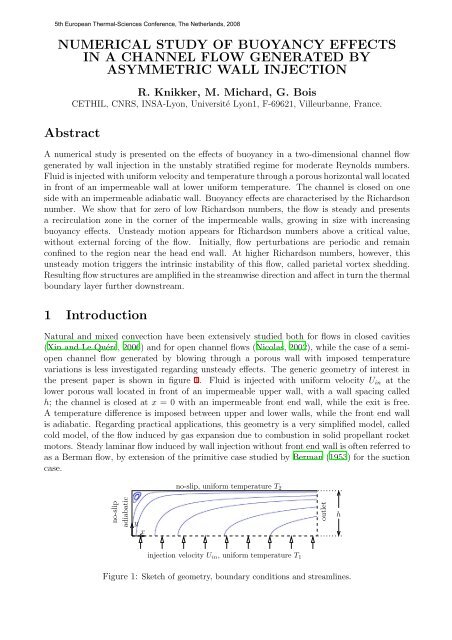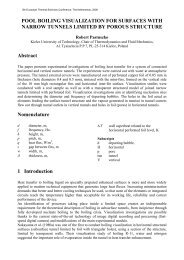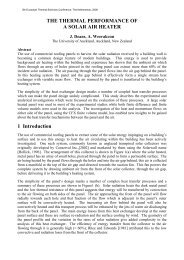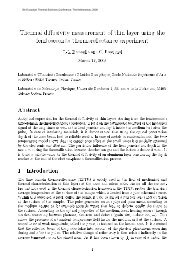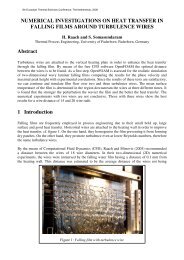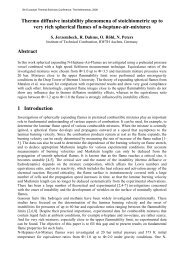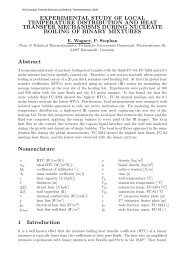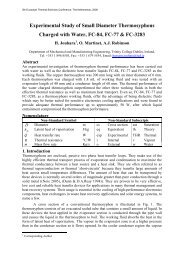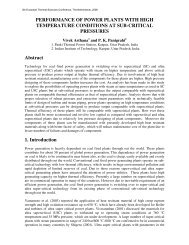Ronnie Knikker, Villeurbanne, F - Eurotherm 2008
Ronnie Knikker, Villeurbanne, F - Eurotherm 2008
Ronnie Knikker, Villeurbanne, F - Eurotherm 2008
Create successful ePaper yourself
Turn your PDF publications into a flip-book with our unique Google optimized e-Paper software.
5th European Thermal-Sciences Conference, The Netherlands, <strong>2008</strong><br />
NUMERICAL STUDY OF BUOYANCY EFFECTS<br />
IN A CHANNEL FLOW GENERATED BY<br />
ASYMMETRIC WALL INJECTION<br />
R. <strong>Knikker</strong>, M. Michard, G. Bois<br />
CETHIL, CNRS, INSA-Lyon, Université Lyon1, F-69621, <strong>Villeurbanne</strong>, France.<br />
Abstract<br />
A numerical study is presented on the effects of buoyancy in a two-dimensional channel flow<br />
generated by wall injection in the unstably stratified regime for moderate Reynolds numbers.<br />
Fluid is injected with uniform velocity and temperature through a porous horizontal wall located<br />
in front of an impermeable wall at lower uniform temperature. The channel is closed on one<br />
side with an impermeable adiabatic wall. Buoyancy effects are characterised by the Richardson<br />
number. We show that for zero of low Richardson numbers, the flow is steady and presents<br />
a recirculation zone in the corner of the impermeable walls, growing in size with increasing<br />
buoyancy effects. Unsteady motion appears for Richardson numbers above a critical value,<br />
without external forcing of the flow. Initially, flow perturbations are periodic and remain<br />
confined to the region near the head end wall. At higher Richardson numbers, however, this<br />
unsteady motion triggers the intrinsic instability of this flow, called parietal vortex shedding.<br />
Resulting flow structures are amplified in the streamwise direction and affect in turn the thermal<br />
boundary layer further downstream.<br />
1 Introduction<br />
Natural and mixed convection have been extensively studied both for flows in closed cavities<br />
(Xin and Le Quéré, 2006) and for open channel flows (Nicolas, 2002), while the case of a semiopen<br />
channel flow generated by blowing through a porous wall with imposed temperature<br />
variations is less investigated regarding unsteady effects. The generic geometry of interest in<br />
the present paper is shown in figure 1. Fluid is injected with uniform velocity U in at the<br />
lower porous wall located in front of an impermeable upper wall, with a wall spacing called<br />
h; the channel is closed at x = 0 with an impermeable front end wall, while the exit is free.<br />
A temperature difference is imposed between upper and lower walls, while the front end wall<br />
is adiabatic. Regarding practical applications, this geometry is a very simplified model, called<br />
cold model, of the flow induced by gas expansion due to combustion in solid propellant rocket<br />
motors. Steady laminar flow induced by wall injection without front end wall is often referred to<br />
as a Berman flow, by extension of the primitive case studied by Berman (1953) for the suction<br />
case.<br />
no-slip, uniform temperature T 2<br />
no-slip<br />
adiabatic<br />
y<br />
x<br />
outlet<br />
h<br />
injection velocity U in , uniform temperature T 1<br />
Figure 1: Sketch of geometry, boundary conditions and streamlines.
5th European Thermal-Sciences Conference, The Netherlands, <strong>2008</strong><br />
In the quasi-isothermal case, the control parameter is the injection Reynolds number Re in<br />
based on U in and h, and the main features of the flow are quite different from that observed<br />
in an open channel flow. First, due to uniform injection, the flow is accelerated and both bulk<br />
velocity U b and Reynolds number based on U b are increasing with the downstream distance<br />
x; therefore, some transition from a laminar state to a turbulent one is expected inside the<br />
channel and/or in boundary layers, even if acceleration is known to delay the transition. The<br />
second main feature of the flow induced by wall injection is that streamlines exhibit a strong<br />
curvature, due to the finite spacing between porous and impermeable walls. As a consequence,<br />
the flow exhibit some intrinsic instability, called parietal vortex shedding (PVS).<br />
For numerical simulation of the velocity field, the front end wall is generally removed in<br />
order to simplify the computations: the flow is supposed to be symmetric around the x = 0<br />
line, and the axial gradients of pressure and vertical velocity are set to zero. In such a case, for<br />
steady, laminar, incompressible flow, the velocity field show a self-similar solution well known<br />
in the literature.<br />
PVS has been predicted theoretically (Casalis et al., 1998) using stability analysis. The<br />
appearance of unsteady motion due to transition and PVS has also been numerically predicted,<br />
using statistical turbulence models (Kourta, 2004) or Large Eddy Simulations (Apte and Yang,<br />
2003; Chaouat and Schiestel, 2005); in some of these computations, a random forcing is introduced<br />
at the injection wall, either to trigger PVS or to simulate fluctuations of the injection<br />
velocity. Some studies take into account the front wall with a no-slip condition; in that case, the<br />
formation of a secondary vortex in the corner near the porous wall is mentioned (Apte and Yang,<br />
2003), but this eddy is generally considered as a numerically induced unwanted vortex.<br />
The characteristics of the Berman flow with both fluid injection and temperature variations<br />
are much less documented in the literature. For uniform injection and laminar, incompressible<br />
flow without front end wall nor buoyancy, both velocity and temperature fields show self-similar<br />
solutions; Fournier et al. (2007) determined the main properties of the temperature self-similar<br />
solution and heat transfer coefficient as a function of Reynolds and Peclet numbers, both for<br />
symmetric and non-symmetric injection; in Fournier et al. (2005), mass and heat transfer have<br />
been numerically studied using statistical models. Ferro and Gnavi (2002) studied the influence<br />
of viscosity variations due to temperature on the stability of the Berman flow, both for suction<br />
and injection cases, but without buoyancy effects. For studies related to solid-propellant rocket<br />
motors applications, the injection velocity and corresponding Reynolds numbers are generally<br />
relatively high; as a consequence, due to the downstream acceleration of the flow, Mach numbers<br />
inside the channel are not small, and compressibility effects can induce some temperature<br />
variations. Nevertheless, theses effects appear as second order phenomena, and do not modify<br />
the basic features of the velocity field, compared to an isothermal case (Apte and Yang, 2003;<br />
Chaouat and Schiestel, 2005). Finally, some papers (Chu et al., 2003) are devoted to the study<br />
of a reacting case with high temperature variations due to injection of reactive products.<br />
The objective of the present study is to investigate the effect of buoyancy on the flow<br />
dynamics in the unstably stratified case, for moderate Reynolds numbers. More precisely, we<br />
are focused on the characterisation of the vortex in the upper left corner due to the end wall,<br />
the appearance of unsteady motion for increasing buoyancy effects and the coupling between<br />
this unsteady motion and the intrinsic instability of the Berman (or Taylor) flow.<br />
Section 2 give in more details the governing equations and control parameters, and an<br />
overview of the numerical methods. In section 3, we present the main features of the flow without<br />
and with buoyancy, in a range of governing parameters where the flow remain steady. We<br />
then show that unsteady motion can appear for larger Richardson numbers. Final conclusions<br />
are drawn in section 4.
5th European Thermal-Sciences Conference, The Netherlands, <strong>2008</strong><br />
2 Methodology<br />
The configuration retained in this study is the two-dimensional channel (figure 1) closed by an<br />
adiabatic impermeable wall at the head end. Fluid at the temperature T 1 is injected homogeneously<br />
through the lower wall and the upper impermeable wall is at constant temperature<br />
T 2 . As mentioned previously, we focus on the case of unstably stratified flow, therefore T 2 < T 1<br />
when gravity forces are pointing in the usual downward direction.<br />
Physical model and governing equations<br />
Radiative heat fluxes and the effect of variable properties are neglected. The fluid motion and<br />
buoyancy effects are modelled by the Boussinesq approximation. Space variables, time, pressure<br />
and velocity components are normalised using the channel height h, the injection velocity U in<br />
and the reference density ρ. Under these assumptions, the continuity, momentum and energy<br />
equations are<br />
∇ · ⃗u = 0<br />
∂⃗u<br />
∂t + ⃗u · ∇⃗u = −∇p + Re−1 ∇ 2 ⃗u + Ri Θ (1)<br />
∂Θ<br />
∂t + ⃗u · ∇⃗ Θ = Pe −1 ∇ 2 Θ<br />
where Θ = (T −T 2 )/(T 1 −T 2 ) is the non-dimensional temperature, Re = U in h/ν is the Reynolds<br />
number based on the injection velocity, channel height and fluid viscosity ν and Pe = Re Pr<br />
is the Péclet number. The control parameter for buoyancy effects is the Richardson number,<br />
defined as<br />
Ri = gβ(T 1 − T 2 )h<br />
U 2 in<br />
where g is the gravitational acceleration and β is the coefficient of volumetric thermal expansion.<br />
Note that the Richardson and Rayleigh numbers are related through Ra = Ri Re 2 Pr. In this<br />
study, the Reynolds number is fixed at Re = 200 and the Prandtl number is Pr = 0.7.<br />
Numerical method<br />
The governing equations (1) are solved on a staggered Cartesian non-uniform grid. Fourthorder<br />
compact discretization (Lele, 1992) is used for all spatial derivatives and the resulting<br />
ODE is advanced in time using the semi-implicit third-order Runge-Kutta/Crank-Nicolson<br />
scheme proposed by Spalart et al. (1991). Similar methods for incompressible flows are used<br />
by Brüger et al. (2005), Kampanis and Ekaterinaris (2006) and Vedy et al. (2003) and have<br />
shown to be accurate and efficient for unsteady incompressible flows. The pressure equation<br />
is discretized in a consistent way using fourth-order schemes and solved using an iterative<br />
technique. A second-order discrete Poisson operator is used at each iteration and solved using<br />
generalized cyclic reduction (Swarztrauber, 1974). A fourth-order accurate solution of the<br />
pressure is obtained after several iterations.<br />
Special attention has been payed to the discretization of the non-linear terms in equations<br />
(1). The advection term in the momentum equation is recast in the so-called skewsymmetric<br />
formulation and discretized using centered compact schemes. In this way, the<br />
method is stable and conserves correctly the total kinetic energy in the limit of isothermal<br />
inviscid flows (Schiestel and Viazzo, 1995). The same procedure applied to the advection term<br />
in the energy equation leads to unphysical oscillations. This term is therefore rewritten in divergence<br />
form and discretized using a third-order upwind interpolation of the temperature followed<br />
by centered compact finite differencing of the energy flux. Thermal energy is then correctly<br />
conserved and the method is stable due to upwinding. The diffusion terms are discretized using
5th European Thermal-Sciences Conference, The Netherlands, <strong>2008</strong><br />
centered schemes. Physical boundary conditions are implemented directly into the schemes<br />
whenever possible. Otherwise, third-order one-sided schemes are used for the boundary points.<br />
A constant pressure boundary condition is used to model the outflow conditions at the right<br />
boundary.<br />
The accuracy of the numerical method is verified using the self-similar solution for the<br />
Berman problem by replacing the head wall with an adiabatic slip boundary. A correct convergence<br />
of the numerical solution is obtained on the entire computational domain, except for<br />
the region near the outlet boundary which is affected by the constant pressure condition. To<br />
minimise the influence of the outlet boundary, all other computations are calculated on a computational<br />
domain of length 30 h. A non-uniform grid is used of size 768 ×64. The grid spacing<br />
in the x-direction varies smoothly from 0.011h near the wall to 0.064h at the outlet, and in<br />
the y-direction from 0.011h near the boundaries to 0.017h at the center of the channel. The<br />
inlet velocity near the head end wall is defined by a boundary layer profile to comply with the<br />
no-slip boundary condition at x = 0. This profile covers roughly 6 grid points near the wall and<br />
is found to have negligible influence on the remaining flow structures. All other computations<br />
are calculated with the no-slip boundary condition at the left wall.<br />
3 Results<br />
Steady flow topology<br />
For small values of the Richardson number and a Reynolds number of Re = 200 the flow is<br />
found to be steady. Figure 2 illustrates the temperature distribution and flow pattern in the<br />
range Ri = 0 to 18. In the absence of buoyancy effects (Ri = 0), a small recirculation zone is<br />
visible in the upper left corner. According to Moffatt (1964), the formation of secondary eddies<br />
is expected in the upper left corner where the flow is dominated by viscous effects. Moffat<br />
predicted that any flow near the corner must consist of a sequence of eddies of decreasing size<br />
and rapidly decreasing intensity. For walls forming a right angle, the relative size of the vortices<br />
falls off in geometric progression whose value is around 10, while their relative intensity decay<br />
in a geometric progression with a common ratio near 2000. Therefore, we expect to capture no<br />
more than one counter-clockwise vortex in the upper left corner.<br />
Figure 2: Effect of buoyancy on the temperature field and streamlines in steady flow conditions. The<br />
downstream region for x > 2 is not shown for clarity.
5th European Thermal-Sciences Conference, The Netherlands, <strong>2008</strong><br />
In the presence of buoyancy effects, cold fluid falls along the end wall towards the porous<br />
wall. On the other hand, injection of hot fluid at the porous wall induces an upward motion;<br />
consequently the cold fluid flowing along the side wall is deviated towards the streamwise<br />
direction, and then transported upwards and remains trapped inside a vortex. As a result, the<br />
size of the counter-clockwise natural recirculation increases with increasing buoyancy effects.<br />
Unsteady flow<br />
Unsteady motion is observed for increasing buoyancy effects. The transition from a steady<br />
to unsteady flow is defined by a critical Richardson number that lies between Ri = 18 and<br />
Ri = 20. In terms of the Rayleigh number, unsteady flow appears between 5.04 × 10 5 and<br />
5.6 × 10 5 . Snapshots of the temperature distribution for several unsteady cases are shown in<br />
figure 3. Pockets of fresh fluid appear at the upper wall giving rise to buoyancy plumes ejected<br />
from the upper wall. Nevertheless, buoyancy effects are not sufficient to prevent damping of<br />
these plumes and the formation of a thermal boundary layer further downstream. For Ri ≤ 90,<br />
the thermal boundary layer is of constant thickness far downstream and described by the selfsimilar<br />
steady solution of the Berman problem. On the other hand, for Ri = 120 this boundary<br />
layer remains unsteady due to its interaction with parietal vortex shedding.<br />
Ri = 30<br />
Ri = 50<br />
Ri = 70<br />
Ri = 90<br />
Ri = 120<br />
Figure 3: Snapshots of the temperature distribution for different values of the Richardson number in<br />
the unsteady flow regime.<br />
Parietal vortex shedding<br />
Figure 4 shows snapshots of the vorticity field at different values of the Richardson number<br />
on a larger part of the computational domain. For high Richardson numbers, organized flow<br />
structures are observed near the injection wall on the right side of the computational domain.<br />
Similar flow structures, characteristic of parietal vortex shedding, are observed in the isothermal<br />
case by Apte and Yang (2003) after introduction of random perturbations to the injection<br />
velocity. For Ri = 90, these flow structures remain weak and disappear further downstream.
5th European Thermal-Sciences Conference, The Netherlands, <strong>2008</strong><br />
For Ri = 120, buoyancy plumes are sufficiently strong to trigger the instability and parietal<br />
vortex shedding is amplified as shown in figure 4. Interestingly, since the temperature field<br />
converges downstream to a boundary layer, the role of buoyancy in the formation of parietal<br />
vortex shedding is limited to the onset of the instability.<br />
Ri = 70<br />
Ri = 90<br />
Ri = 120<br />
Figure 4: Snapshots of the vorticity fields for different values of the Richardson number. An aspect<br />
ratio of 3 : 1 is used to enhance the visibility of flow structures.<br />
The mean fluctuation of temperature and velocity are shown in figure 5. For Ri = 90,<br />
the unsteady flow motion is strongest in the region near the head end vortex but decreases<br />
rapidly further downstream. For Ri = 120, fluctuations of both velocity and temperature<br />
are distributed over a much larger domain. Downstream of the vortex region, large velocity<br />
fluctuations are observed near the injection wall which are directly related to the presence of<br />
parietal vortex shedding. The temperature and velocity fluctuations near the upper boundary<br />
are due to perturbations of the boundary layer and the large gradients of temperature and<br />
velocity at this location.<br />
(a) Ri = 90<br />
Ri = 120<br />
(b) Ri = 90<br />
Ri = 120<br />
Figure 5: Standard deviation of temperature (a) and velocity fluctuation (b) for Ri = 90 and Ri = 120.<br />
The image aspect ratio is 3 : 1.
5th European Thermal-Sciences Conference, The Netherlands, <strong>2008</strong><br />
Spectral analysis<br />
Frequency spectra for the heat flux averaged along the upper wall for Ri = 30 and 120 are<br />
shown in figure 6a. At the lower Richardson number, the strong fundamental peak in the<br />
spectrum and the well-defined harmonics indicate that flow structures are essentially periodic.<br />
The power spectrum at Ri = 120 is a broad-band spectrum, despite the regular pattern of<br />
coherent structures resulting from parietal vortex shedding.<br />
Figure 6b plots the fundamental frequency of the periodic signal as a function of the Richardson<br />
number in the range Ri = 20 to 90 for which the flow is essentially periodic. Similar spectra<br />
and the same fundamental frequencies are obtained from the shear force at the head end wall.<br />
The frequency at Ri = 20 is of the order of U in /h and increases with buoyancy force. A jump<br />
in the frequency is observed around Ri = 49.<br />
Power spectral density<br />
10 0 Dimensionless frequency<br />
10 −5<br />
10 −10<br />
Ri=30<br />
Ri=120<br />
Dimensionless frequency<br />
3<br />
2.5<br />
2<br />
1.5<br />
1<br />
0.5<br />
(a)<br />
10 −15<br />
0 2 4 6 8 10<br />
(b)<br />
0<br />
0 20 40 60 80 100<br />
Richardson number<br />
Figure 6: Spectral analysis of the heat flux averaged along the upper wall; (a) power spectra for<br />
Ri = 30 and Ri = 120, (b) frequency of the most energetic mode for Richardson numbers between 0<br />
and 90. The frequency is expressed in non-dimensional units using U in /h.<br />
4 Conclusions<br />
The following main conclusions can be drawn from this two-dimensional numerical study. For<br />
zero or weak buoyancy force, the flow is steady and presents a recirculation zone in the upper<br />
left corner. The size of this recirculation zone increases with increasing buoyancy effect. The<br />
flow motion becomes unsteady above a certain critical Richardson number. For values near<br />
the critical one, flow perturbations are periodic and confined to the region near the head end<br />
wall. The fundamental frequency depends on the strength of the buoyancy force. For larger<br />
values of the Richardson number, the unsteady motion triggers the natural instability (PVS)<br />
of this flow. To our knowledge, this work is the first demonstration in this flow configuration of<br />
unsteady effects resulting from buoyancy forces. Note that no artificial forcing is used in this<br />
study and boundary conditions are steady.<br />
However, it is well known that for channel flows of the Poiseuille-Rayleigh-Bénard type threedimensional<br />
effects in the form of longitudinal rolls appear with increasing thermal stratification<br />
(Xin et al., 2006). It remains to be explored under which conditions similar flow structures<br />
appear in the present accelerated channel flow, in particular with respect to the unsteady twodimensional<br />
flow structures observed in this study. Further research is also needed to understand<br />
the physical mechanisms underlying unsteadiness and determine the essential parameters of this<br />
flow as well as the cause of the frequency jump observed in the periodic flow regime.
5th European Thermal-Sciences Conference, The Netherlands, <strong>2008</strong><br />
References<br />
S. Xin and P. Le Quéré. Natural-convection flows in air-filled, differential heated cavities with adiabatic<br />
horizontal walls. Numerical Heat Transfer, Part A, 50:437–466, 2006.<br />
X. Nicolas. Bibliographical review on the Poiseuille-Rayleigh-Bénard flows: the mixed convection flows<br />
in horizontal rectangular ducts heated from below. International Journal of Thermal Sciences, 41:<br />
961–1016, 2002.<br />
A. Berman. Laminar flow in channels with porous wall. J. Appl. Phys., 24 (9):456–475, 1953.<br />
G. Casalis, G. Avalon, and J.-Ph. Pineau. Spatial instability of planar channel flow with fluid injection<br />
through porous walls. Phys. Fluids, 10(10):2558–2568, 1998.<br />
A. Kourta. Instability of channel flow with fluid injection and parietal vortex shedding. Computers<br />
& Fluids, 33(2):155–178, 2004.<br />
S. Apte and V. Yang. A large-eddy simulation study of transition and flow instability in a porouswalled<br />
chamber with mass injection. J. Fluid Mech., 477:215–225, 2003.<br />
B. Chaouat and R. Schiestel. A new partially integrated transport model for subgrig-scale stresses<br />
and dissipation rate for turbulent developing flows. Physics of Fluids, 17(6):065106, 2005.<br />
C. Fournier, M. Michard, and F. Bataille. Heat transfer in a laminar channel flow generated by<br />
injection through porous walls. Journal of Fluids Engineering, 129:1048–1057, 2007.<br />
C Fournier, F Bataille, and M Michard. Transition characteristics of flowfield in a non-isothermal<br />
duct with wall injection. In Proceedings of 4th International Conference on Computational Heat<br />
and Mass transfer, pages 899–904, Paris, France, 2005.<br />
S. Ferro and G. Gnavi. Effects of temperature-dependent viscosity in channels with porous walls. Phys<br />
Fluids, 14(2):839 – 849, 2002.<br />
W.-W. Chu, V. Yang, and J. Majdalani. Premixed flame response to acoustic waves in a porous-walled<br />
chamber with surface mass injection. Combustion and Flame, 133(3):359–370, May 2003.<br />
S.K. Lele. Compact finite difference schemes with spectral-like resolution. J. Comput. Phys., 103(1):<br />
16–42, 1992.<br />
P.R. Spalart, R.D. Moser, and M.M. Rogers. Spectral methods for the Navier-Stokes equations with<br />
one infinite and two periodic directions. J. Comput. Phys., 96(2):297–324, 1991.<br />
A. Brüger, B. Gustafsson, P. Lotstedt, and J. Nilsson. High order accurate solution of the incompressible<br />
Navier-Stokes equations. J. Comput. Phys., 203(1):49–71, February 2005.<br />
N.A. Kampanis and J.A. Ekaterinaris. A staggered grid, high-order accurate method for the incompressible<br />
Navier-Stokes equations. J. Comput. Phys., 215(2):589–613, July 2006.<br />
E. Vedy, S. Viazzo, and R. Schiestel. A high-order finite difference method for incompressible fluid<br />
turbulence simulations. Int. J. Num. Meth. Fluids, 42(11):1155–1188, 2003.<br />
P.N. Swarztrauber. Direct method for the discrete solution of separable elliptic equations. J. Numer.<br />
Anal., SIAM, 11:1136–1150, 1974.<br />
R. Schiestel and S. Viazzo. A Hermitian-Fourier numerical method for solving the incompressible<br />
Navier-Stokes equations. Computers & Fluids, 24(6):739–752, 1995.<br />
H.K. Moffatt. Viscous and resistive eddies near a sharp corner. J. Fluid Mech., 18:1–18, 1964.<br />
S. Xin, X. Nicolas, and P. Le Quéré. Stability analyses of longitudinal rolls of Poiseuille-Rayleigh-<br />
Bénard flows in air-filled channels of finite transversal extension. Numerical Heat Transfer, Part A,<br />
50:467–490, 2006.


